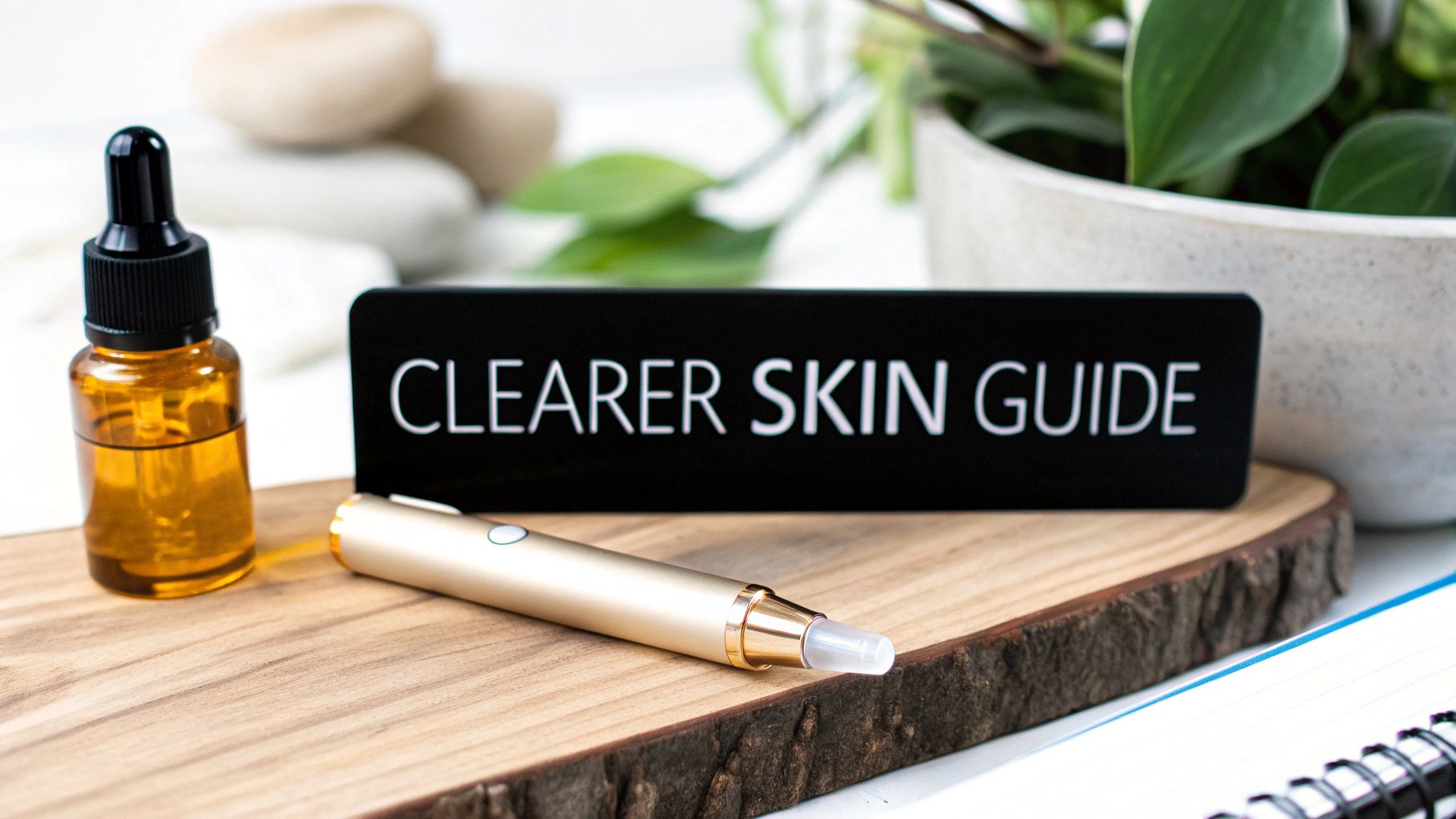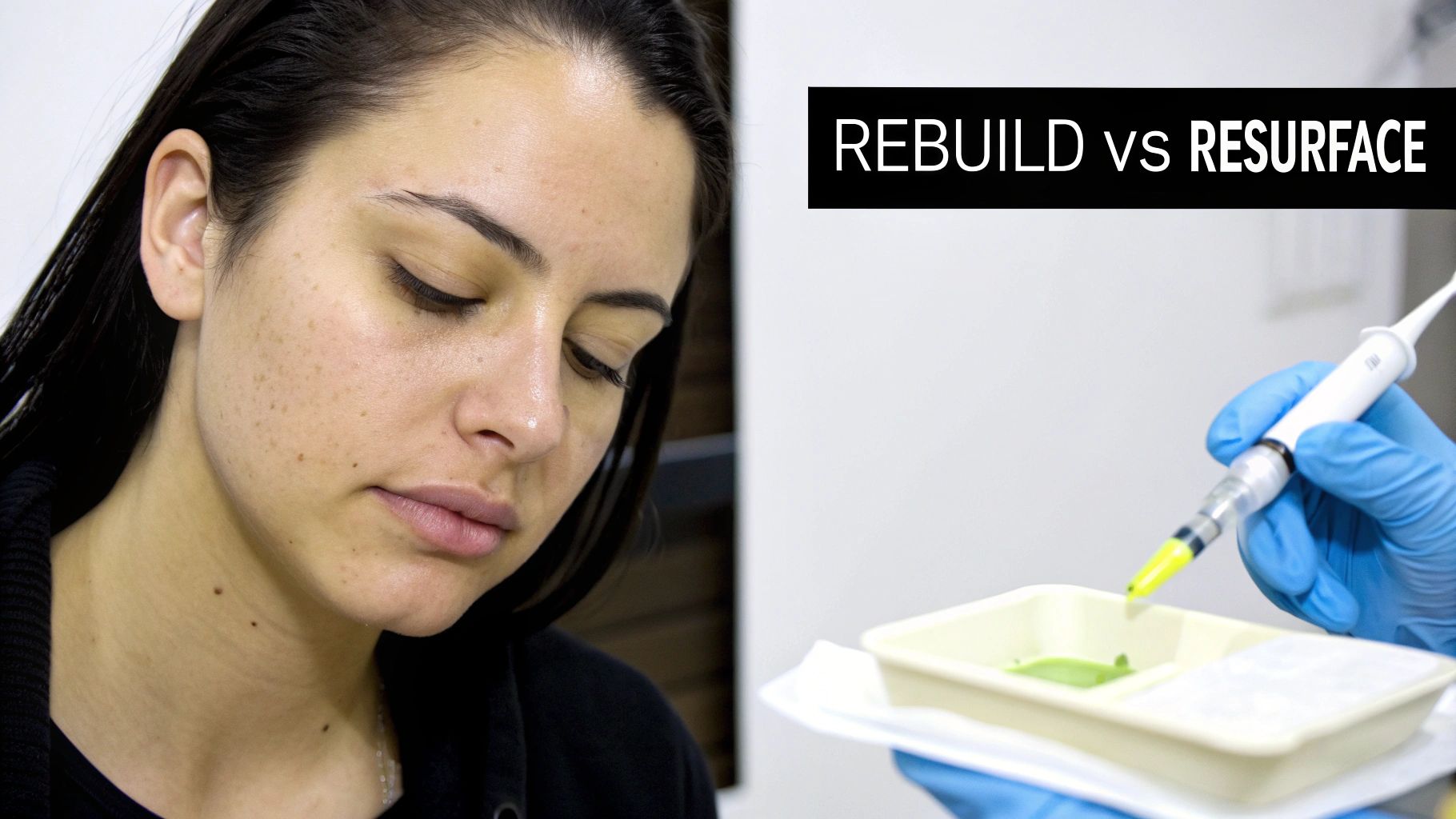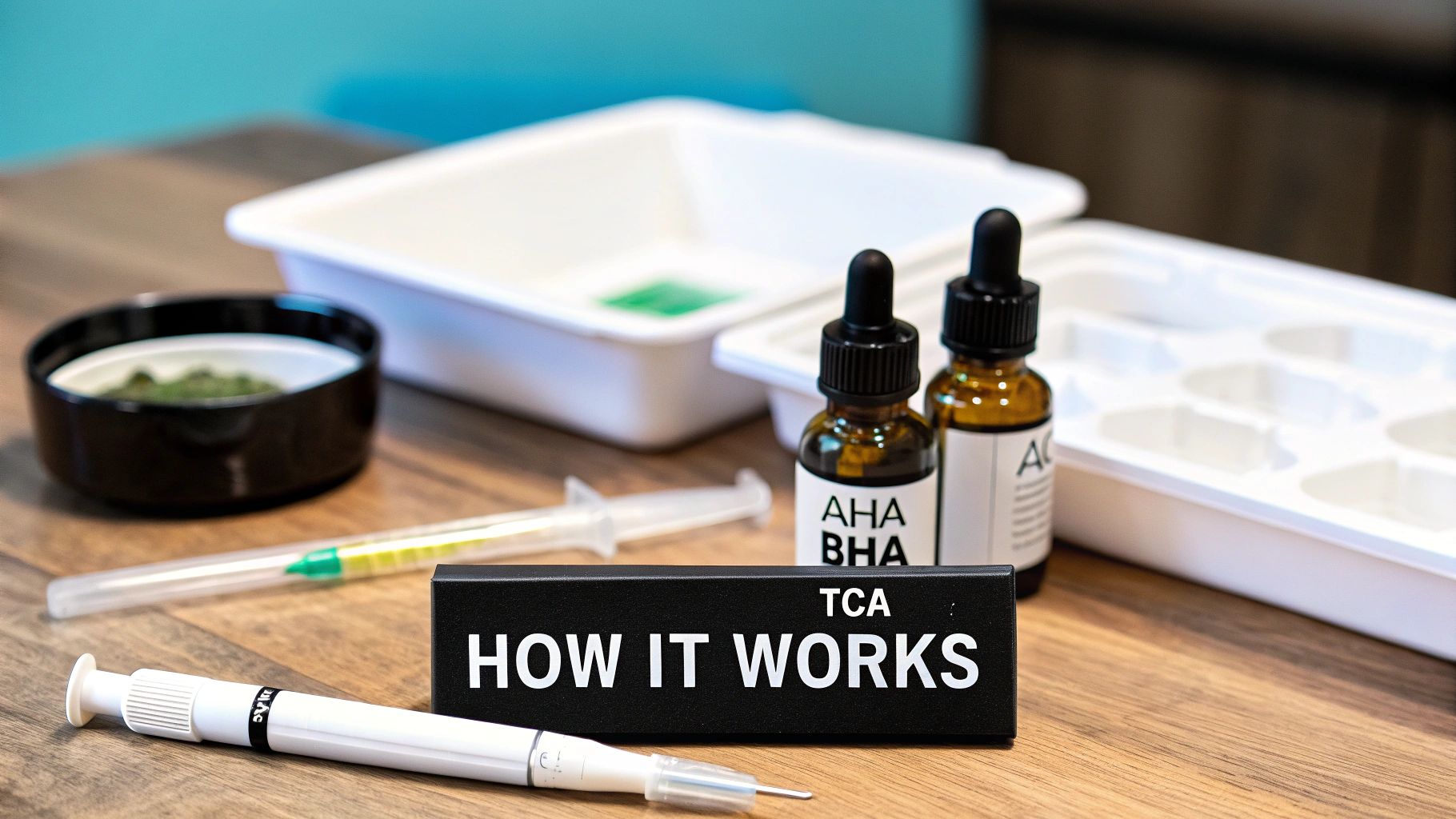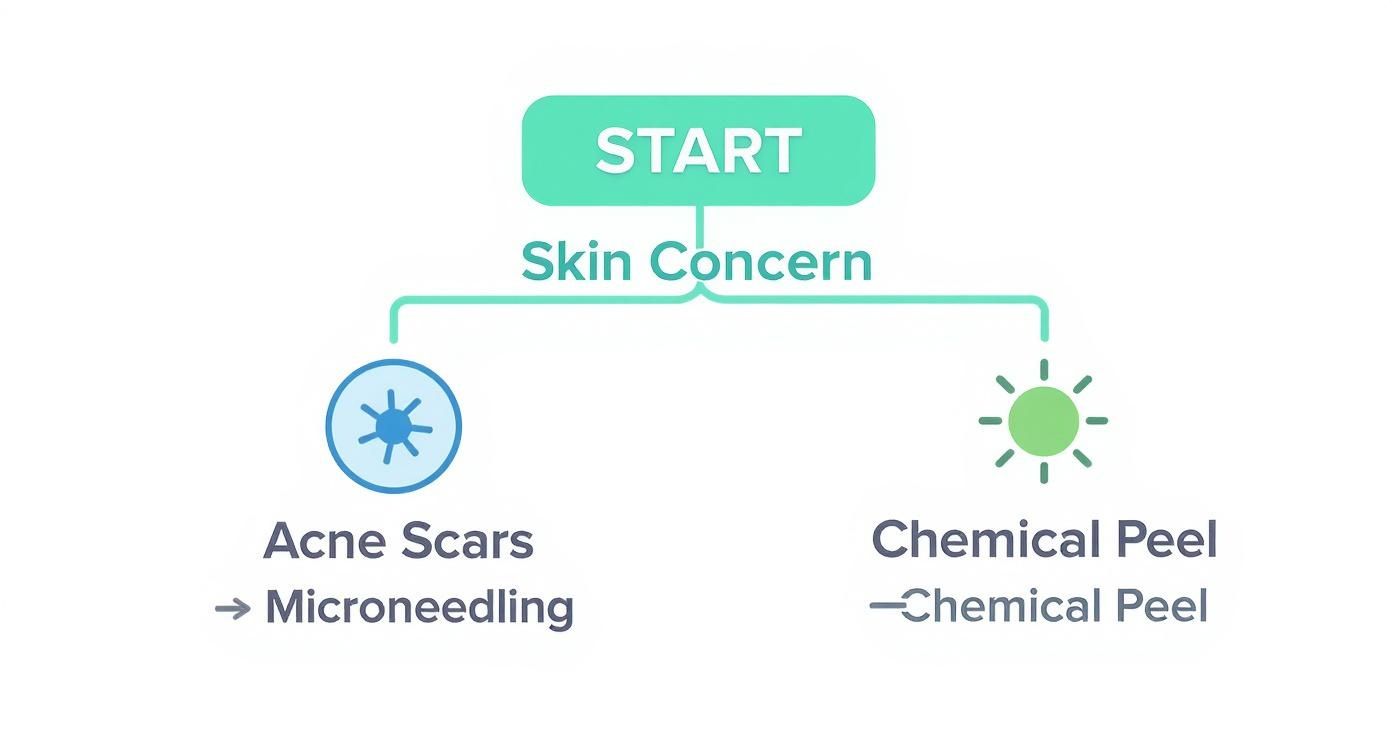
December 10, 2025
A Patient's Guide to Nonsurgical Cosmetic Procedures
Explore popular nonsurgical cosmetic procedures like Botox and fillers. Learn how they work, the benefits, costs, and what to expect from an expert guide.
Oct 23, 2025

When you get down to it, the biggest difference between microneedling and a chemical peel is how they work. Microneedling is all about rebuilding your skin from the inside out, while a chemical peel resurfaces it from the top down.
Think of it this way: microneedling gets your body to heal itself and build fresh collagen for deep, structural repairs. A chemical peel, on the other hand, uses specialized acids to shed the damaged, outer layers of skin, revealing a smoother surface. The right choice for you really depends on whether you're looking for structural improvement or a surface-level refresh.
Trying to decide between microneedling and a chemical peel can feel overwhelming, but it gets a lot simpler when you understand what each one is designed to do. I often tell my clients to think of it like renovating a house. Microneedling is like shoring up the foundation, while a chemical peel is like giving the exterior a perfect new coat of paint. Both make the house look better, but they tackle completely different problems.

Microneedling is what we call collagen induction therapy. The procedure creates thousands of tiny, controlled micro-injuries in the skin, which kicks your body’s natural healing process into high gear. This process tells your body to produce brand new collagen and elastin—the proteins that keep your skin firm, elastic, and structured.
A chemical peel is a form of controlled chemical exfoliation. We apply a specific acid solution that dissolves the "glue" holding dead or damaged skin cells together. By lifting away those outer layers, the peel unveils the healthier, more vibrant skin waiting just beneath the surface.
For a quick side-by-side, this table breaks down the core differences in a really straightforward way.
Ultimately, what matters most is what you want to fix. If you're dealing with deeper issues like atrophic acne scars or a noticeable loss of firmness, the internal rebuilding that microneedling provides is usually the better bet. Advanced treatments like Genius RF Microneedling take this even further, using radiofrequency energy to seriously tighten the skin.
But if your main concerns are on the surface—things like sun spots, overall dullness, or a rough texture—the immediate resurfacing from a chemical peel often delivers the results you’re looking for. Getting this basic distinction right is the first step to making a smart choice for your skin.
To really get to the bottom of the microneedling vs. chemical peel debate, you have to understand the science behind them. They both aim to rejuvenate the skin, but they get there through completely different routes. One is all about rebuilding from the inside out, while the other is about strategically stripping away damage from the surface.

There’s a reason microneedling is often called collagen induction therapy—it perfectly captures what’s happening. The treatment uses a device with tiny, sterile needles to create thousands of invisible micro-channels in the skin.
This isn't about damaging or removing skin. Instead, it’s a clever way to kickstart the body's natural healing response. These controlled micro-injuries signal your skin to get to work repairing itself.
The main result is a major boost in the production of two key proteins:
Essentially, microneedling tricks your skin into reinforcing itself from deep within. It builds a newer, stronger, and smoother foundation, which is why it works so well on issues that start in the dermal layer, like pitted acne scars and deep-set lines.
Key Insight: Microneedling doesn't add anything foreign or take anything away. It simply taps into your body's own powerful regenerative engine to create real, structural improvements that last.
The tools for this have come a long way. While you might see at-home dermal rollers, professional treatments almost always involve advanced microneedling pens. These devices give the practitioner incredible control over needle depth and speed, which allows them to tailor the treatment precisely to different areas and concerns for a safer, more effective result.
A chemical peel, on the other hand, works through controlled chemical exfoliation. Rather than creating a physical prompt for repair, it uses a specific acid-based solution to dissolve the glue holding dead, damaged cells together on the skin’s surface.
This process removes the tired outer layers of the epidermis, letting the healthier, brighter skin underneath shine through. The type of acid and its strength dictate how deep the peel goes, which directly impacts the results you'll see and how much downtime you'll need.
There are three main categories of chemical peels:
Choosing the right peel is crucial and depends entirely on your skin goals. If you want to learn more, our guide on what chemical peels do and who they are for offers a much deeper dive.
Ultimately, the "microneedling vs. chemical peel" decision comes down to this core difference: microneedling triggers internal regeneration, while a chemical peel performs a strategic surface renewal.
Deciding between microneedling and a chemical peel isn’t just about the science behind them; it’s about picking the right tool for the job. Your specific skin goals are what really matter here. While both can give you incredible results, they work in fundamentally different ways and shine in different scenarios.
Let's get into the nitty-gritty of how they compare for common issues like acne scars, fine lines, dark spots, and rough texture. This head-to-head breakdown will help you figure out which treatment is the smarter choice for you.
When you're dealing with atrophic—or indented—acne scars, microneedling is almost always the frontrunner. We're talking about those pesky ice pick, boxcar, and rolling scars, which are essentially little divots left behind from a loss of collagen.
Microneedling goes right to the source of the problem. It creates tiny micro-injuries that kickstart your skin's natural healing process, prompting it to build brand new collagen deep down. Over a series of sessions, this new tissue network literally "fills in" the scar from the bottom up, raising the indented skin to be more level with the surface.
A chemical peel, on the other hand, works by resurfacing the top layers of skin. A medium or deep peel can definitely help by softening the sharp edges of shallow scars and improving the overall landscape, but it can't rebuild the foundational collagen that's missing. For more on this, check out our guide on acne scar treatments that really work.
Key Takeaway: For indented acne scars, microneedling rebuilds the foundational support structure your skin has lost. A chemical peel smooths the surface, but microneedling works to correct the underlying structural deficit.
This isn't just theory. A 2021 clinical study directly compared microneedling to a 35% glycolic acid peel for acne scars on deeper skin tones (Fitzpatrick types IV, V, and VI). The difference was stark: 73.33% of microneedling patients saw a significant improvement in their scars, while only 35% of the chemical peel group saw similar results. You can read the full findings from this comparative study on skinofcolorupdate.com.
Both treatments are power players against fine lines and wrinkles, but the best one for you depends on what you're trying to fix. Are we talking about fine surface lines or deeper-set expression wrinkles?
Here's an easy way to think about it: microneedling is like adding more stuffing to a cushion to make it plump and smooth. A chemical peel is like ironing the fabric on top. Both methods work, but they tackle the problem from completely different angles.
For widespread discoloration on the skin's surface—sun spots, melasma, or just a generally uneven tone—a chemical peel often gets the win.
The acids used in peels are specifically chosen to break up and lift away pigmented cells from the epidermis. This makes them incredibly efficient at clearing up patches of hyperpigmentation and giving you a brighter, more even-toned complexion, sometimes after just one or two treatments.
Microneedling can also help with pigmentation by speeding up cell turnover and creating micro-channels that allow brightening serums to penetrate deeper. Its main job, though, is remodeling the skin's structure, not aggressive exfoliation. So, it typically takes more sessions to achieve the same kind of pigment-clearing results you'd get from a well-chosen peel.
A Quick Look at How They Handle Pigmentation
The bottom line is that a chemical peel actively removes the problem cells, while microneedling coaxes the body into gradually replacing them with new, healthy ones.
If your main goal is simply better-looking skin—smoother, brighter, and with less noticeable pores—both treatments are excellent choices.
A light chemical peel acts like a quick "reset button" for your skin's surface. It dissolves the buildup of dead cells that cause dullness and roughness, leaving you with an instant glow and silky-smooth feel. It's a perfect pick-me-up or maintenance treatment.
Microneedling, however, offers a deeper, more structural improvement to texture and pores. The new collagen it generates helps to reinforce the walls of your pores, making them look tighter and smaller over time. This foundational change creates a genuinely refined skin surface that keeps getting better for months after your last session. For a lasting change in your skin's texture, microneedling often delivers a more profound and durable result.
Deciding between microneedling and a chemical peel isn't about which one is "better" in a general sense. The best treatment is the one that’s right for your skin—your unique type, history, and goals. Making that call means taking a close look at everything from your skin tone to its sensitivity level.
A huge piece of the puzzle is your skin's natural pigmentation, which we often classify using the Fitzpatrick skin scale. This scale is invaluable for predicting how your skin will react to different treatments, especially those that trigger an inflammatory healing response.
If you have a darker skin tone (typically Fitzpatrick types IV, V, and VI), the risk of post-inflammatory hyperpigmentation, or PIH, is a major consideration. PIH is when dark spots appear after the skin has been through some kind of trauma or inflammation.
This is where microneedling really shines. It creates tiny, controlled vertical channels in the skin without using heat or harsh chemicals that can disturb your pigment-producing cells (melanocytes). As a result, it carries a much lower risk of causing unwanted dark spots.
On the other hand, certain chemical peels—especially medium-to-deep ones—can be riskier for melanin-rich skin. The chemical exfoliation can sometimes provoke an uneven healing response, leading to discoloration. For this reason, many patients with darker complexions lean toward microneedling to avoid these pigmentation concerns. You can find more details on choosing the right option at viva-vitality.com.
Expert Insight: For my clients with skin of color, my first priority is always to get them the results they want while minimizing any risk of pigmentation issues. I often start with microneedling for textural concerns because it’s a reliable and safe way to stimulate collagen without aggravating pigment.
Your skin's general temperament is another key factor. If you have highly reactive or sensitive skin, you need to choose your treatment carefully.
Microneedling can be tailored for sensitivity by using shorter needle depths, stimulating the skin just enough to get results without causing major irritation. This makes it a great choice for many people with sensitive skin looking to work on texture or fine lines.
Chemical peels can be trickier. Even a very superficial peel might trigger significant redness and discomfort for sensitive types. And if you have an active skin condition, the choice becomes even more clear-cut:
Finally, whether your skin is naturally oily or dry can point you toward one treatment over the other.
If you have oily and acne-prone skin, a chemical peel with salicylic or glycolic acid can work wonders. These acids cut through oil to exfoliate the surface and deep-clean pores, leading to clearer, smoother skin.
For those with dry or mature skin, the main goal is often to boost hydration and firmness. This is microneedling’s sweet spot. The treatment itself builds collagen for a plumping effect, while the micro-channels it creates allow hydrating serums to penetrate much more deeply into the skin.
Here's a table to help you match your skin type and concerns with the most suitable treatment.
This table provides a great starting point, but always remember that a professional consultation is the best way to determine the perfect treatment plan for your specific needs.

As the infographic highlights, it often comes down to this: structural problems like acne scars respond best to the rebuilding power of microneedling, whereas surface issues like sun damage are better addressed by the resurfacing action of a chemical peel.
When you're deciding on a skin treatment, what happens after you leave the office is just as important as the procedure itself. Let's break down the real-world recovery and treatment timelines for microneedling and chemical peels, because this is often the deciding factor for many people.

Microneedling has a reputation for being pretty manageable in terms of downtime. Immediately after a session, you can expect your skin to look and feel like you've had a mild sunburn. This redness and sensitivity usually calm down within 24 to 72 hours. It's the kind of procedure you can get on a Friday and be back to work on Monday without much fuss.
A chemical peel's recovery is a totally different ballgame, and it all comes down to the peel's intensity. Your experience can be anything from a minor bit of redness to a full-on healing period where you'll want to lay low at home.
The Reality of Downtime: Think of it this way: with microneedling, you’re dealing with a couple of days of redness. With a medium chemical peel, you're actively managing visible sheets of skin shedding for about a week. You absolutely have to plan social events and work commitments around that difference.
The other piece of the puzzle is how many treatments you'll need and how long it will take to see the final results. Are you looking for gradual improvement, or do you want a more immediate impact from a single session?
Microneedling is all about cumulative results. The treatment works by kickstarting your body's own collagen-building process, so it takes time and consistency. A standard treatment plan is usually 3 to 6 sessions, with each one spaced 4 to 6 weeks apart. This gap is crucial; it gives your skin the time it needs to heal and regenerate. You’ll probably see a nice glow after the first session, but the real, structural changes in skin texture and firmness show up months after your last treatment.
On the other hand, a single medium-depth chemical peel can deliver a pretty dramatic change for surface-level problems like sun spots or uneven tone. You might get the results you want from just one treatment. For other issues, a series of lighter peels might be recommended, but the potential for a "one-and-done" solution is a big draw. This makes peels a great choice if you're aiming for a faster fix for specific concerns.
Ultimately, getting a clear picture of these timelines helps you set the right expectations and choose the procedure that truly fits your lifestyle.
When it comes to the "microneedling vs. chemical peel" debate, sometimes the best answer isn't choosing one over the other. For tough-to-treat issues like deep acne scars or significant sun damage, a combined approach can deliver results that neither treatment could pull off alone. It’s like a one-two punch for skin rejuvenation.
This isn’t about doing both at the same time. The strategy lies in careful timing and leveraging what each treatment does best.
Here’s how a professional might structure a combination therapy:
In short, the peel refines the surface, and the microneedling rebuilds the structural foundation.
Expert Insight: I often explain it to my patients like this: Think of it as refinishing an old wooden table. The chemical peel is like sanding it down, removing the old, chipped varnish and surface stains. Then, microneedling is the deep conditioning treatment that restores the wood's integrity and strength from within.
This isn’t just theory; it’s backed by solid research. One randomized controlled trial with 120 patients looked specifically at combining these treatments for atrophic acne scars. The results were clear: the combination approach was significantly more effective than either microneedling or a chemical peel used alone.
Patients in the combined group saw their Goodman-Baron scar scale scores improve by an average of 2.87 ± 0.83. In contrast, those who received just one of the treatments saw an improvement of 2.03 ± 1.16. You can dive into the specifics of these findings on combined scar treatments. For stubborn, deep-seated scarring, combining forces isn't just another option—it’s often the best one.
A word of caution: this is absolutely not a home-care project. Stacking potent treatments like these requires an expert hand. A board-certified dermatologist or plastic surgeon is needed to choose the right peel strength, determine the correct microneedling depth, and—most importantly—time the sessions perfectly. Done right, this advanced protocol can tackle complex skin issues with incredible success.
When you're trying to choose between microneedling and a chemical peel, the practical questions are often the most important. Let's dig into what you can really expect when it comes to pain, safety, and how quickly you'll see a change in your skin.
Honestly, everyone's pain tolerance is different, but both treatments are designed to be quite manageable. For microneedling, a topical numbing cream is applied beforehand, which makes a huge difference. Most people say it feels more like a light vibration or a bit of a scratching sensation than actual pain.
Chemical peels are a different story, and the feeling depends entirely on the peel's strength. A light, superficial peel might just give you a mild tingle or a feeling of warmth. Go for a medium-depth peel, and you can expect a more intense stinging during the application, but it’s temporary and your provider will be monitoring you the entire time.
You've probably seen at-home dermal rollers and low-strength acid peels on the market, but it's crucial to understand they are not the same as a professional treatment. Not even close. Professional microneedling uses sterile, adjustable needles to reach the exact depth required to actually stimulate new collagen. At-home rollers can't do this safely and often cause more harm than good.
When it comes to peels, the professional-grade versions use much higher concentrations of acids. An expert knows how to apply these correctly to avoid serious risks like burns, scars, or hyperpigmentation. For real results and your own safety, stick with a pro.
This is where the two treatments really diverge. A chemical peel often delivers a pretty quick payoff. Once the initial flaking and peeling are done—usually within a week or so—you'll likely see brighter, smoother skin right away. The results come fast because you're literally removing the dull, outer layers.
Microneedling plays the long game. You might notice an immediate "glow" from minor inflammation and increased blood flow, but the real magic happens over time. The new collagen your body builds becomes noticeable around 4-6 weeks after a session. Those structural improvements keep getting better for months, which is why a series of treatments is usually recommended for the best outcome.
At Cape Cod Plastic Surgery, our experts can give you a personalized consultation to figure out the absolute best path for your skin. To get started, schedule an appointment by visiting us at https://ccplasticsurgery.com.

December 10, 2025
Explore popular nonsurgical cosmetic procedures like Botox and fillers. Learn how they work, the benefits, costs, and what to expect from an expert guide.

December 10, 2025
Exploring Your Breast Surgery Choices: From Cancer Treatment to Cosmetic Enhancements

December 9, 2025
Tired of looking tired? Uncover what causes under eye bags, from genetics to lifestyle, and explore expert-backed prevention tips and treatment options.